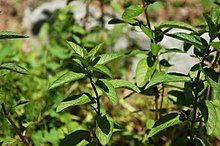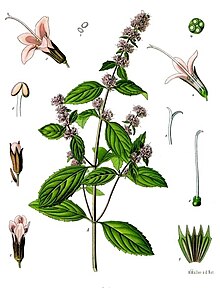Peppermint
| Peppermint | |
|---|---|

| |
| Peppermint (Mentha x piperita) | |
| Scientific classification | |
| Kingdom: | |
| (unranked): | |
| (unranked): | |
| (unranked): | |
| Order: | |
| Family: | |
| Genus: | |
| Binomial name | |
| Mentha × piperita | |
Peppermint (Mentha × piperita, also known as M. balsamea Willd. [1]) is a hybrid mint, a cross between the watermint (Mentha aquatica) and spearmint (Mentha spicata). The plant, indigenous to Europe, is now widespread in cultivation throughout all regions of the world[2]. It is found wild occasionally with its parent species.[2][3]
Nomenclature and taxonomy
This section needs expansion. You can help by adding to it. |
List of the cultivars
A number of cultivars have been selected for garden use:[4]
- Mentha × piperita 'Candymint'. Stems reddish.
- Mentha × piperita 'Citrata' (Eau De Cologne Mint). Leaves aromatic, hairless.
- Mentha × piperita 'Crispa'. Leaves wrinkled.
- Mentha × piperita 'Lime Mint'. Foliage lime-scented.
- Mentha × piperita 'Variegata'. Leaves mottled green and pale yellow.
- Mentha × piperita 'Chocolate Mint'. Flowers open from bottom up; reminiscent of flavour in Andes Chocolate Mints, a popular confection.[5]
Commercial cultivars may include
- Dulgo pole
- Zefir
- Bulgarian population #2
- Clone 11-6-22
- Clone 80-121-33
This section needs expansion. You can help by adding to it. (6 June 2009) |
Botany

Peppermint was first described by Carolus Linnaeus from specimens that had been collected in England; he treated it as a species,[6] but it is now universally agreed to be a hybrid.[7]
It is a herbaceous rhizomatous perennial plant growing to 30–90 cm (12–35 in) tall, with smooth stems, square in cross section. The rhizomes are wide-spreading, fleshy, and bare fibrous roots. The leaves are from 4–9 cm (1.6–3.5 in) long and 1.5–4 cm (0.59–1.57 in) cm broad, dark green with reddish veins, and with an acute apex and coarsely toothed margins. The leaves and stems are usually slightly hairy. The flowers are purple, 6–8 mm (0.24–0.31 in) long, with a four-lobed corolla about 5 mm (0.20 in) diameter; they are produced in whorls (verticillasters) around the stem, forming thick, blunt spikes. Flowering is from mid to late summer. The chromosome number is variable, with 2n counts of 66, 72, 84, and 120 recorded.[3][8][4]
Ecology
Peppermint typically occurs in moist habitats, including stream sides and drainage ditches. Being a hybrid, it is usually sterile, producing no seeds and reproducing only vegetatively, spreading by its rhizomes. If placed, it can grow anywhere, with a few exceptions. [3][8]
It is an invasive species in the Great Lakes region, noted since 1843[9].
Uses

Peppermint is sometimes regarded as 'the world's oldest medicine', with archaeological evidence placing its use at least as far back as ten thousand years ago.[citation needed]
Peppermint has a high menthol content, and is often used as a flavouring in tea, ice cream, confectionery, chewing gum, and toothpaste. The oil also contains menthone and menthyl esters, particularly menthyl acetate.[10] It is the oldest and most popular flavour of mint-flavoured confectionery. Peppermint can also be found in some shampoos and soaps, which give the hair a minty scent and produce a cooling sensation on the skin.

In 2007, Italian investigators reported that 75% of the patients in their study who took peppermint oil capsules for four weeks had a major reduction in irritable bowel syndrome (IBS) symptoms, compared with just 38% of those who took a placebo.[11]
Similarly, some poorly designed earlier trials found that peppermint oil has the ability to reduce colicky abdominal pain due to IBS with an NNT (number needed to treat) around 3.1,[12] but the oil is an irritant to the stomach in the quantity required and therefore needs wrapping for delayed release in the intestine. Peppermint relaxes the gastro-esophageal sphincter, thus promoting belching. Restaurants usually take advantage of this effect by taking advantage of its use as a confectionery ingredient, which they then call "after-dinner mints."
Peppermint flowers are large nectar producers and honey bees as well as other nectar harvesting organisms forage them heavily. A mild, pleasant varietal honey can be produced if there is a sufficient area of plants.
Peppermint oil is used by commercial pesticide applicators, in the EcoSmart Technologies line of products, as a natural insecticide.[13]
Outside of its native range, areas where peppermint was formerly grown for oil often have an abundance of feral plants, and it is considered invasive in Australia, the Galápagos Islands, New Zealand,[14] and in the United States.[15]
Cultivation
Peppermint generally thrives in shade and expands quickly by underground stolons. If you choose to grow peppermint, it is advisable to plant it in a container, otherwise it can rapidly take over a whole garden. It needs a good water supply, and is ideal for planting in part-sun to shade areas.
The leaves and flowering tops are the usable portion of the plant. They are collected as soon as the flowers begin to open and then are carefully dried. The wild form of the plant is less suitable for this purpose, with cultivated plants having been selected for more and better oil content. Seeds sold at stores labelled peppermint generally will not germinate into true peppermint, but into a particularly poor-scented spearmint plant. The true peppermint might rarely produce seeds, but only by fertilization from a spearmint plant, and contribute only their own spearmint genes.
Cultivars
A number of cultivars have been selected for garden use:[4]
- Mentha × piperita 'Candymint'. Stems reddish.
- Mentha × piperita 'Citrata' (Eau De Cologne Mint). Leaves aromatic, hairless.
- Mentha × piperita 'Crispa'. Leaves wrinkled.
- Mentha × piperita 'Lime Mint'. Foliage lime-scented.
- Mentha × piperita 'Variegata'. Leaves mottled green and pale yellow.
- Mentha × piperita 'Chocolate Mint'. Flowers open from bottom up; reminiscent of flavour in Andes Chocolate Mints, a popular confection.[16]
Toxicology
The toxicity studies of the plant have received controversial results. Some authors reported that the plant may induce hepatic diseases, while others found that it is of protective functions against the liver damages which are caused by heavy metal inductions [17], [18]. In addition to that, the toxicities of the plant seem to variate from one cultivar to another [19] and are dose dependent [17], [20].
See also
- Altoids
- Candy cane
- Insect repellent
- List of plants used as medicine
- Mentha
- Mint chocolate
- Peppermint tea
- Spearmint (Mentha spicata)
Notes
- ^ World Health Organization. "WHO monographs on selected medicinal plants Volume 2" (PDF). Retrieved 3 June.
{{cite web}}: Check date values in:|accessdate=(help); Cite has empty unknown parameter:|coauthors=(help); Unknown parameter|accessyear=ignored (|access-date=suggested) (help) - ^ a b Euro+Med Plantbase Project: Mentha × piperita
- ^ a b c Flora of NW Europe: Mentha × piperita
- ^ a b c Huxley, A., ed. (1992). New RHS Dictionary of Gardening. Macmillan ISBN 0-333-47494-5.
- ^ Mountain Valley Growers: Mentha piperita cv. Chocolate Mint
- ^ Linnaeus, C. (1753). Species Plantarum 2: 576–577.
- ^ Harley, R. M. (1975). Mentha L. In: Stace, C. A., ed. Hybridization and the flora of the British Isles page 387.
- ^ a b Blamey, M. & Grey-Wilson, C. (1989). Flora of Britain and Northern Europe. ISBN 0-340-40170-2
- ^ "List of invasive species in the Great Lakes Great Lakes United / Union Saint-Laurent Grands Lacs". Retrieved 2009-02-07.
- ^ PDR for Herbal Medicines, 4th Edition, Thomson Healthcare, page 640. ISBN 978-1563636783
- ^ Cappello, G. (2007). "Peppermint oil (Mintoil) in the treatment of irritable bowel syndrome: A prospective double blind placebo-controlled randomized trial". Digestive and Liver Disease. 39 (6): 530–536. doi:10.1016/j.dld.2007.02.006.
{{cite journal}}: Cite has empty unknown parameter:|month=(help); Unknown parameter|coauthors=ignored (|author=suggested) (help) - ^ Bandolier Journal: Peppermint oil for irritable bowel syndrome
- ^ EcoSMART Product label
- ^ Pacific Island Ecosystems at Risk: Mentha x piperita
- ^ USDA Plants Profile: Mentha x piperita
- ^ Mountain Valley Growers: Mentha piperita cv. Chocolate Mint
- ^ a b Akdogan, Mehmet (2004). "Investigation of biochemical and histopathological effects of Mentha piperitaLabiatae and Mentha spicata Labiatae on liver tissue in rats". Human & Experimental Toxicology. 23 (1): 21–28. Retrieved 3 June.
{{cite journal}}: Check date values in:|accessdate=(help); Cite has empty unknown parameter:|coauthors=(help); Unknown parameter|accessyear=ignored (|access-date=suggested) (help) - ^ Sharma, Ambika; et al. (2007). "Protective Effect of Mentha piperita against Arsenic-Induced Toxicity in Liver of Swiss Albino Mice". Basic & Clinical Pharmacology & Toxicology. 100 (4): 249–257. Retrieved 3 June.
{{cite journal}}: Check date values in:|accessdate=(help); Cite has empty unknown parameter:|coauthors=(help); Explicit use of et al. in:|first=(help); Unknown parameter|accessyear=ignored (|access-date=suggested) (help) - ^ Akdogan, Mehmet (2003). "Investigation of biochemical and histopathological effects of Mentha piperita L. and Mentha spicata L. on kidney tissue in rats". Human & Experimental Toxicology. 22 (4): 213–219. Retrieved 3 June.
{{cite journal}}: Check date values in:|accessdate=(help); Cite has empty unknown parameter:|coauthors=(help); Unknown parameter|accessyear=ignored (|access-date=suggested) (help) - ^ Akdogan, Mehmet; et al. (2004). "Effect of Mentha piperita (Labiatae) and Mentha spicata (Labiatae) on iron absorption in rats". Toxicology and Industrial Health. 20 (6–10): 119–122. Retrieved 3 June.
{{cite journal}}: Check date values in:|accessdate=(help); Cite has empty unknown parameter:|coauthors=(help); Explicit use of et al. in:|first=(help); Unknown parameter|accessyear=ignored (|access-date=suggested) (help)
